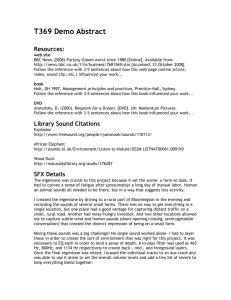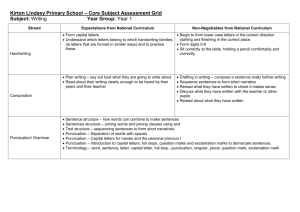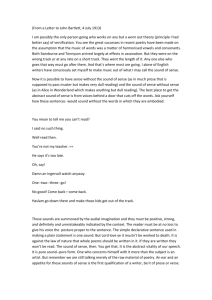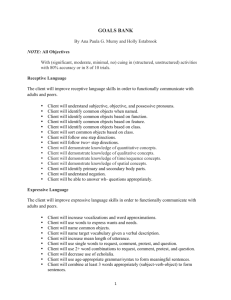Speech and language therapy years two and three checklist
advertisement
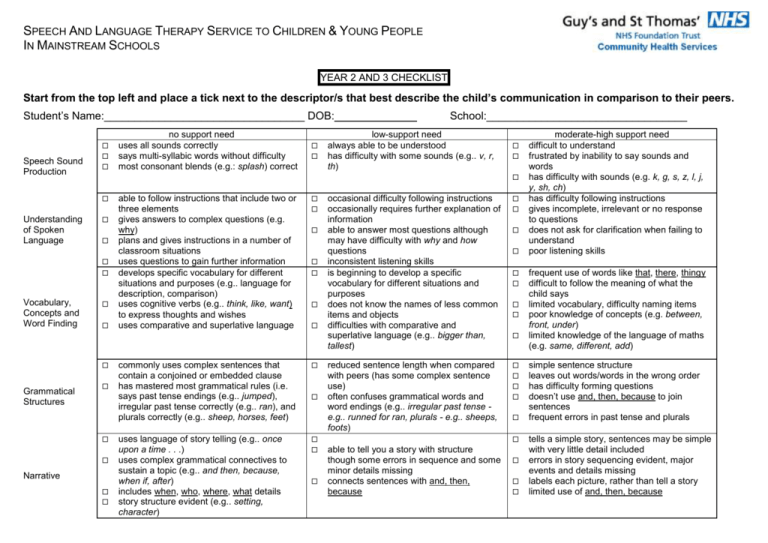
SPEECH AND LANGUAGE THERAPY SERVICE TO CHILDREN & YOUNG PEOPLE IN MAINSTREAM SCHOOLS YEAR 2 AND 3 CHECKLIST Start from the top left and place a tick next to the descriptor/s that best describe the child’s communication in comparison to their peers. Student’s Name:_________________________________ DOB: Speech Sound Production Vocabulary, Concepts and Word Finding Grammatical Structures low-support need always able to be understood has difficulty with some sounds (e.g.. v, r, th) Understanding of Spoken Language no support need uses all sounds correctly says multi-syllabic words without difficulty most consonant blends (e.g.: splash) correct School:_________________________________ Narrative able to follow instructions that include two or three elements gives answers to complex questions (e.g. why) plans and gives instructions in a number of classroom situations uses questions to gain further information develops specific vocabulary for different situations and purposes (e.g.. language for description, comparison) uses cognitive verbs (e.g.. think, like, want) to express thoughts and wishes uses comparative and superlative language commonly uses complex sentences that contain a conjoined or embedded clause has mastered most grammatical rules (i.e. says past tense endings (e.g.. jumped), irregular past tense correctly (e.g.. ran), and plurals correctly (e.g.. sheep, horses, feet) uses language of story telling (e.g.. once upon a time . . .) uses complex grammatical connectives to sustain a topic (e.g.. and then, because, when if, after) includes when, who, where, what details story structure evident (e.g.. setting, character) occasional difficulty following instructions occasionally requires further explanation of information able to answer most questions although may have difficulty with why and how questions inconsistent listening skills is beginning to develop a specific vocabulary for different situations and purposes does not know the names of less common items and objects difficulties with comparative and superlative language (e.g.. bigger than, tallest) reduced sentence length when compared with peers (has some complex sentence use) often confuses grammatical words and word endings (e.g.. irregular past tense e.g.. runned for ran, plurals - e.g.. sheeps, foots) able to tell you a story with structure though some errors in sequence and some minor details missing connects sentences with and, then, because moderate-high support need difficult to understand frustrated by inability to say sounds and words has difficulty with sounds (e.g. k, g, s, z, l, j, y, sh, ch) has difficulty following instructions gives incomplete, irrelevant or no response to questions does not ask for clarification when failing to understand poor listening skills frequent use of words like that, there, thingy difficult to follow the meaning of what the child says limited vocabulary, difficulty naming items poor knowledge of concepts (e.g. between, front, under) limited knowledge of the language of maths (e.g. same, different, add) simple sentence structure leaves out words/words in the wrong order has difficulty forming questions doesn’t use and, then, because to join sentences frequent errors in past tense and plurals tells a simple story, sentences may be simple with very little detail included errors in story sequencing evident, major events and details missing labels each picture, rather than tell a story limited use of and, then, because Social Communication Phonological Awareness Fluency / Stuttering Voice Mother Tongue Assessment no support need can sustain a conversation with a number of audiences (e.g.. teachers, peers, adults) stays on topic and takes into account the audience and purpose when speaking uses tone, intonations and gesture to add to meaning of what is said able to segment, manipulate/join sound units can define and recognise the concepts of sound, letter and word able to generate words beginning with a sound understands riddles, jokes and puns based on word play low-support need needs some help to hold a conversation and stay on topic speaks but gives limited information problems verbally interacting with their peers (e.g. negotiating, changing roles, dealing with conflict) some difficulty in the segmentation and manipulation of sound units able to give examples of sounds, letters, words and sentences and possesses some awareness of literacy concepts (e.g. sound, letter, word) moderate-high support need needs significant help to hold a conversation difficulty remaining on topic rarely speaks, difficulties in group discussion doesn’t use “classroom talking rules” appropriately unable to recognise rhyming words by listening unable to give examples of sounds and letters possesses little awareness of print conventions possesses little awareness of concepts (e.g. sounds, letters, words) speaks fluently sound and word repetitions heard when frequently repeats sounds or words the child is excited, tired or nervous physically struggles to get words out often uses ums and ers to get started becomes frustrated due to stammering If the child has an unusual quality of voice e.g. hoarse, nasal or monotonous which persists for more than 3 weeks, please refer to the GP. □ no difficulties in home language or English □ language skills in home language are as □ language skills in both home language and expected, some difficulties in English – English well below expected level, errors please contact EMA support evident in both languages Who is able to work with this child regularly on a speech/language program? (e.g. teacher, LSA, SENCO, parent, grandparent) What additional support/ strategies have been/ are being used with this child? Were they effective? What are the outcomes you want from speech and language therapy support? How will you know when these have been met? Class Teacher Signature: ________________________________Name: 2 Date:


